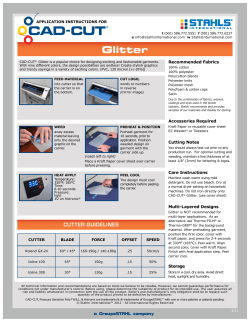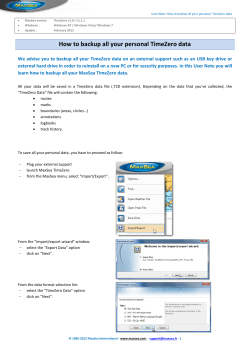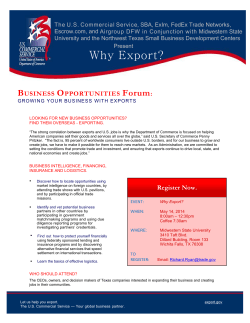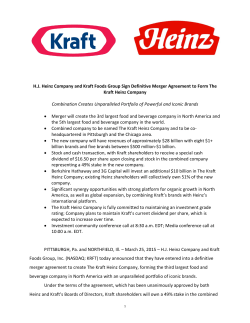
Market entry strategies and territorial expansion
Market entry strategies and territorial expansion Internationalization occurs ... • Internationalization occurs when the firm expands its R and D, production, selling and other business activities into international markets. Inward/outward internationalization • A natural way of internationalizing would be first to get involved in inward activities (imports) and thereafter in outward activities (export). • Relations and knowledge gathered from import activities could thus be used when the firm engages in export activities. Natural way of development... 1. Marketing, sales 2. and services 3. Production 1. Buying 2. at foreign market import export Marketing, sales, Services at foreign market Market entry strategies Once the firm has chosen target market abroad, the question arises as to the best way to enter those markets. Classification of market entry modes: • Export mode – 100 % externalizing (low control, low risk, high flexibility) • Intermediate modes (contractual modes) (shared control and risk, split ownership) • Hierarchical modes (investment modes) – 100 % internalizing (high control, high risk, low flexibility) Kraft Foods Inc´s (2011) • NEW DELHI/MUMBAI: As the world’s second biggest processed foods company, Illinois-based Kraft Foods Inc’s $18.9 billion takeover of British confectionery maker Cadbury is finalised after a protracted boardroom battle, Kraft Foods’ finally gets a clean sweep of the only big emerging market it did not yet have a presence in, India. • Cadbury India came under the Kraft Foods fold after the US-based firm acquired British candy maker, Cadbury Plc for $19.6 billion in January this year. Asked if Cadbury India will be selling more products from Kraft portfolio, Kripalu said: "As of now we are still focusing on our core confectionery business." He, however, said integration process is still going on in terms of synergising distribution channels of Cadbury and Kraft in India . Commenting on the overall plans of Cadbury India, he said: "Capacity is a challenge for us, as we look to drive up volumes. We need to expand it and we will be doing it significantly." He said the expansions will take place at the company's existing six facilities in India but declined to share details such as investments and envisaged additional output. Cadbury sells chocolate brands, including Cadbury Dairy Milk, 5 Star and Perk, along with snacks Cadbury Bytes and health drink Bournvita among others in India. Starting to manufacture TANG in INDIA • NEW DELHI: Cadbury India on Thursday said it will start local manufacturing of parent Kraft Foods' orange drink Tang , while it will also embark on a capacity expansion for its confectionery products. "We will start local manufacturing of Tang in India. We are rejuvenating it and we will start producing it within this fiscal," Cadbury India Managing Director Anand Kripalu told reporters in Delhi on the sidelines of a CII event. He said Tang, which has been imported from Thailand to serve the Indian market so far, will be produced at Kraft's Hyderabad plant. "It is a legacy plant of Kraft in Hyderabad, which has not been utilised. We will start manufacturing there," he said. • Asked if Cadbury India will be selling more products from Kraft portfolio, Kripalu said: "As of now we are still focusing on our core confectionery business." He, however, said integration process is still going on in terms of synergising distribution channels of Cadbury and Kraft in India . Commenting on the overall plans of Cadbury India, he said: "Capacity is a challenge for us, as we look to drive up volumes. We need to expand it and we will be doing it significantly." He said the expansions will take place at the company's existing six facilities in India but declined to share details such as investments and envisaged additional output. Cadbury sells chocolate brands, including Cadbury Dairy Milk, 5 Star and Perk, along with snacks Cadbury Bytes and health drink Bournvita among others in India. Group assignment • What kind of specific marketing information the international company needs to know to design its marketing program for Indian market? Define it according to 4 marketing tools – product (demand and supply), price, place, promotion. • What to consider at the selection of a suitable intermediary – business partner at the foreign market? Group assignment • Identify opportunities and threats for INDIA from being involved in the process of internationalization and globalization. • Identify the factors of attractiveness of INDIA for foreing direct investors and foreign businesses operating. • What kind of specific marketing information the international company needs to know to design its marketing program for Indian market? Define it according to 4 marketing tools – product, price, place, promotion Factors influencing the choice of entry mode • Internal factors: - firm size, international experience, product/services • External factors: – socio-cultural distance between home country and host country – Country risk/demand uncertainty – Market size and growth – Direct and indirect trade barriers – Intensity of competition, small number of relevant intermediaries available Indirect export modes • Indirect export occurs when the exporting manufacturer uses independent organizations located in the producer´s country Direct export modes • direct export occurs when a manufacturer or exporter sells directly to an importer or buyer located in a foreign market area. Choice of intermediary The selection of a suitable intermediary can be a problematic procedure. What to consider?
© Copyright 2025













